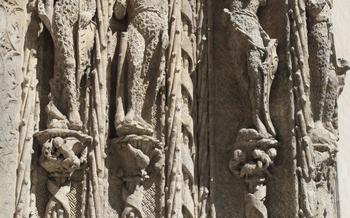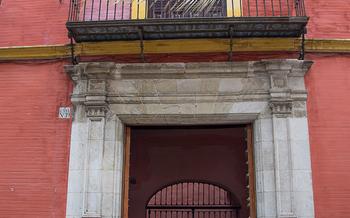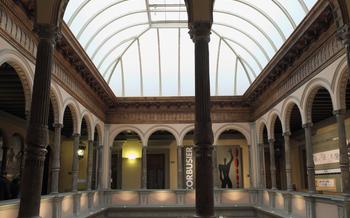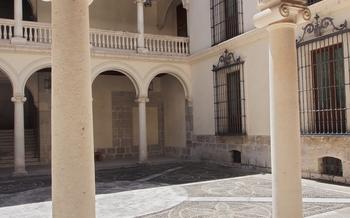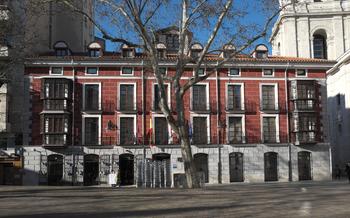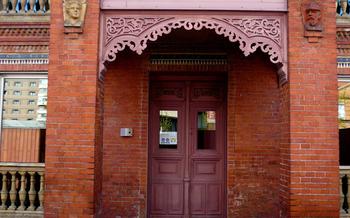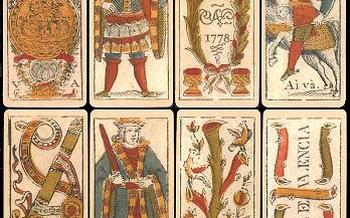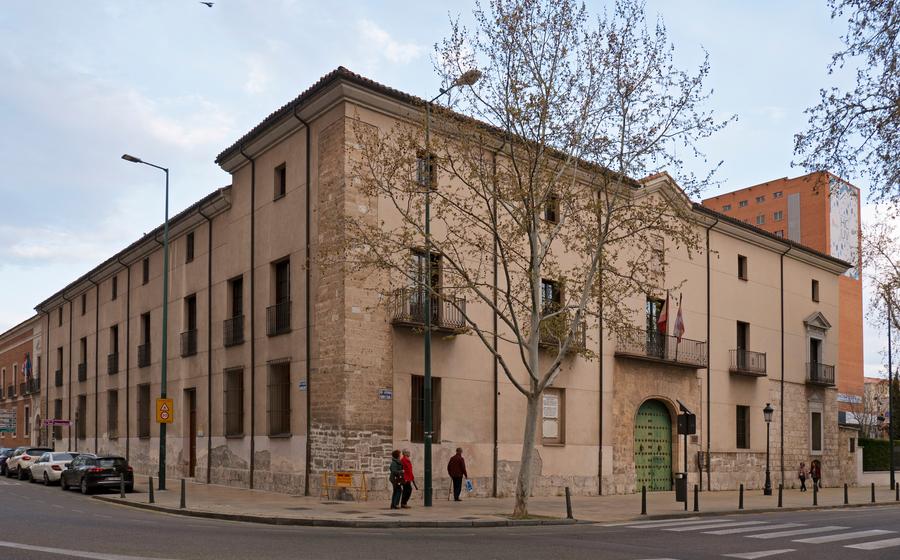
Palacio de los Vivero
- Palacio de los Vivero: An Architectural Masterpiece
- Unveiling the Grand Staircase
- Discovering the Hall of Mirrors
- The Throne Room: A Symbol of Power
- The Chapel: A Sacred Space
- The Library: A Treasure Trove of Knowledge
- The Gardens: A Tranquil Oasis
- Guided Tours: Unlocking Hidden Stories
- Special Events and Exhibitions
- Photography Tips: Capturing the Palace's Beauty
- Practical Information: Planning Your Visit
- Insider Tip: Uncovering Hidden Gems
Palacio de los Vivero: An Architectural Masterpiece
Historical Significance:
The Palacio de los Vivero stands as a testament to Valladolid' prominent and influential families in the city. Over the centuries, the palace has been witness to significant historical events, playing a role in shaping Valladolid's cultural and political landscape.
Architectural Style:
The palace showcases a harmonious blend of Renaissance and Gothic architectural styles, reflecting the transition between these two influential periods. Its elegant facade, adorned with intricate carvings and decorative elements, is a testament to the skill and artistry of its creators. The palace's interior features grand halls, ornate ceilings, and a majestic staircase, all contributing to its opulent and awe-inspiring atmosphere.
Location and Accessibility:
Conveniently located in the heart of Valladolid's historic center, the Palacio de los Vivero is easily accessible on foot or by public transportation. Its proximity to other notable landmarks, such as the Plaza Mayor and the Cathedral of Valladolid, makes it an ideal starting point for exploring the city's rich cultural heritage.
Unveiling the Grand Staircase
The grand staircase of the Palacio de los Vivero is a masterpiece of architectural design and craftsmanship. Its intricate stonework and balustrades showcase the exceptional skill and attention to detail that went into its creation. The staircase is of impressive size and design, sweeping gracefully from the ground floor to the upper levels. It is a symbolic representation of the palace's grandeur and serves as a fitting entrance to the opulent rooms and halls that lie beyond.
Discovering the Hall of Mirrors
Amidst the grand chambers of the Palacio de los Vivero, the Hall of Mirrors stands out as a testament to opulence and extravagance. Step into this enchanting space, and be captivated by the shimmering reflections that dance across its walls. An exquisite collection of mirrors adorns every corner, creating an illusion of infinite depth and grandeur.
The Hall of Mirrors is renowned for its unique characteristics, setting it apart from similar halls found in other palaces. Its walls are adorned with intricately carved frames, each mirror reflecting a different perspective of the room, creating a mesmerizing kaleidoscope of light and shadow. The ceiling, adorned with delicate frescoes and sparkling chandeliers, adds to the ethereal ambiance.
Throughout history, the Hall of Mirrors has played host to countless significant events and witnessed many intriguing anecdotes. It served as a grand ballroom, where the elite of society gathered for lavish parties and celebrations. The hall's reflective surfaces captured the elegance of the dancers, the vibrant colors of their attire, and the infectious energy that filled the air.
In addition to its social significance, the Hall of Mirrors also holds historical importance. It was here that crucial negotiations and diplomatic meetings took place, shaping the course of events that influenced the fate of the region. The walls of the hall seem to whisper tales of intrigue, power struggles, and alliances forged between noble families.
The Throne Room: A Symbol of Power
The throne room, located in the heart of the Palacio de los Vivero, stands as a testament to the power and authority once wielded by the marquises of Vivero. Elaborately decorated with intricate carvings, opulent tapestries, and gleaming chandeliers, this grand chamber exudes an aura of majesty and prestige.
The central feature of the room is the ornate throne, a symbol of the marquises' sovereignty and the embodiment of their power. Crafted from finely polished wood and adorned with intricate carvings, the throne is positioned on a raised platform, drawing the eye and commanding attention.
Throughout history, the throne room has played host to countless important events and ceremonies. Here, the marquises held court, received dignitaries, and made decisions that shaped the fate of their lands. The walls bear witness to alliances forged, treaties signed, and royal proclamations made, all contributing to the rich tapestry of the palace's history.
The throne itself holds symbolic significance. It represents the power and authority invested in the marquises, a power that was derived from the king and bestowed upon them as representatives of the crown. The throne serves as a reminder of the intricate web of relationships and obligations that bound the marquises to their sovereign and to the people they ruled.
As visitors gaze upon the throne, they can almost hear the echoes of history reverberating within its walls. The throne room stands as a tangible link to the past, inviting visitors to step back in time and experience the grandeur and power of a bygone era.
The Chapel: A Sacred Space
The Palacio de los Vivero boasts a magnificent chapel that exudes a profound sense of spirituality and religious devotion. Steeped in history, this sacred space holds immense significance for the Catholic faith and has witnessed countless religious ceremonies and events throughout the centuries. Its striking architectural features, intricate artwork, and peaceful ambiance create an environment conducive to contemplation and worship.
The chapel's design is a testament to the architectural prowess of its creators. Its vaulted ceilings and elegant arches evoke a sense of grandeur and reverence. The walls are adorned with stunning frescoes and paintings depicting biblical scenes and religious figures, adding to the chapel's spiritual aura. The altar, a focal point of the space, is adorned with intricate carvings and sculptures, showcasing the exceptional craftsmanship of the era.
Beyond its aesthetic beauty, the chapel holds deep religious significance. It has served as a place of worship for generations of Catholic faithful and has witnessed countless baptisms, marriages, and other religious ceremonies. The chapel's acoustics are designed to enhance the sound of prayers and hymns, creating a truly immersive and spiritual experience for those in attendance.
Whether you are a devout Catholic or simply someone seeking a moment of peace and reflection, the chapel of the Palacio de los Vivero offers a sanctuary for the soul. Its serene atmosphere and sacred ambiance invite visitors to connect with their spirituality and find solace within its walls.
The Library: A Treasure Trove of Knowledge
The library at the Palacio cultural significance. Housing an extensive collection of books and manuscripts, it is a treasure trove of knowledge and a haven for bibliophiles. Among its shelves, visitors can find rare and valuable editions, some dating back centuries. These rare books offer a glimpse into the past, preserving the thoughts and ideas of influential figures from various eras.
The library's collection covers a wide range of subjects, from history and philosophy to literature and science. It is a valuable resource for researchers, scholars, and anyone interested in delving deeper into Valladolid's past and cultural heritage. The library's knowledgeable staff is always ready to assist visitors in finding the information they seek, making it an ideal place to conduct research or simply browse and discover new perspectives.
Beyond its impressive collection, the library itself is a work of art. The room is adorned with intricate carvings and sculptures, creating an atmosphere of grandeur and reverence. The high ceilings and large windows allow natural light to flood in, illuminating the rows of bookshelves and creating a warm and inviting ambiance. Visitors to the library can spend hours exploring its collection, discovering hidden gems and gaining a deeper understanding of Valladolid's rich cultural heritage.
The Gardens: A Tranquil Oasis
Strolling through the meticulously landscaped gardens of the Palacio de los Vivero is like stepping into a secret paradise. Lush greenery, vibrant flowers, and graceful fountains create a serene and inviting atmosphere that beckons visitors to linger and soak in the tranquility. Sculptures and statues, nestled amidst the foliage, add an artistic touch to the natural beauty. Secluded corners, adorned with comfortable benches, offer the perfect spots for relaxation and contemplation. From the gardens, visitors can enjoy stunning panoramic views of the city, a reminder of the vibrant urban landscape that surrounds this tranquil oasis.
Guided Tours: Unlocking Hidden Stories
Guided tours at the Palacio de los Vivero offer a unique opportunity to delve deeper into the palace's rich history and uncover its hidden stories. Knowledgeable guides lead visitors through the grand halls and chambers, sharing fascinating insights about the palace's construction, past residents, and significant events that have taken place within its walls.
With a guided tour, visitors can access areas of the palace that are typically closed to the public, granting them a behind-the-scenes glimpse into the palace's inner workings. Guides provide captivating anecdotes and stories about the people who lived and worked here, bringing the palace's history to life. They also offer expert interpretations of the palace's architecture, artwork, and symbolism, helping visitors to understand the deeper meanings behind the grand facade.
For those seeking a truly personalized experience, private guided tours can be arranged, allowing visitors to tailor the tour to their specific interests and curiosities. Whether it's learning about the palace's role in Spanish history, admiring the intricate details of its architecture, or discovering the hidden stories of its former occupants, a guided tour of the Palacio de los Vivero promises an unforgettable journey into the heart of this architectural masterpiece.
Special Events and Exhibitions
The Palacio de los Vivero is not just a historical monument but also a vibrant cultural hub that hosts a variety of special events and exhibitions throughout the year. These events provide visitors with unique opportunities to experience the palace's grandeur and history in new and exciting ways.
Temporary exhibitions showcasing diverse art forms, from contemporary paintings to ancient artifacts, are regularly organized in the palace's spacious halls. These exhibitions offer a platform for local and international artists to display their works and share their perspectives with the public.
Cultural events, concerts, and performances are also held in the palace, transforming its elegant spaces into vibrant venues for artistic expression. Visitors can enjoy classical music concerts, theatrical performances, dance recitals, and more, all within the enchanting setting of the palace.
Attending special events or exhibitions at the Palacio de los Vivero is a fantastic way to immerse yourself in the palace's rich history and vibrant cultural scene. It's an opportunity to witness the palace come alive with creativity, energy, and the spirit of celebration.
Photography Tips: Capturing the Palace's Beauty
Photography Tips: Capturing the Palace's Beauty
The Palacio de los Vivero offers a treasure trove of photographic opportunities, from its grand architecture to its intricate details. Here are some tips to help you capture the palace's beauty in your photos:
-
Ideal angles and lighting conditions: The best time to photograph the palace is during the golden hours of dawn and dusk, when the warm light casts a soft glow on the building's facade. Experiment with different angles to find the most flattering perspective, such as shooting from below to emphasize the palace's grandeur or from a distance to capture its full majesty.
-
Tips for capturing intricate details: To capture the intricate carvings, sculptures, and other details that adorn the palace, use a macro lens or zoom in with your camera. Focus on specific elements, such as the delicate tracery of the windows or the expressive faces of the gargoyles, to create striking close-up shots.
-
Enhancing photos with editing techniques: Once you've captured your shots, use editing software to enhance their colors, contrast, and sharpness. Experiment with different filters and adjustments to create a unique and personal style. You can also use HDR (High Dynamic Range) photography to capture the full range of tones and details in the palace's architecture.
Practical Information: Planning Your Visit
To ensure a memorable and hassle-free visit to the Palacio de los Vivero, it's essential to plan your trip carefully. The palace is generally open to the public from Tuesday to Sunday, with varying hours depending on the season. It's advisable to check the official website or contact the palace directly for the most up-to-date information on operating hours.
Admission fees are typically charged, with discounts available for students, seniors, and groups. Guided tours are highly recommended for a more comprehensive and immersive experience, as they offer insights into the palace's history, architecture, and significance. Reservations for guided tours can be made in advance to avoid disappointment.
The Palacio de los Vivero is wheelchair accessible, with ramps and elevators provided for visitors with disabilities. Accessibility options should be confirmed when making reservations or upon arrival.
After exploring the palace, you can enhance your visit by exploring the surrounding area. The vibrant Plaza Mayor, with its lively atmosphere and numerous restaurants, is just a short walk away. The Museo Nacional de Escultura, showcasing an impressive collection of religious sculptures, is also nearby.
To make the most of your trip to Valladolid, consider exploring other attractions such as the Cathedral, the Colegio de San Gregorio, and the Campo Grande park. A variety of dining options are available in the city, ranging from traditional Spanish cuisine to international fare.
By planning your visit carefully and taking advantage of the available resources, you can ensure an enriching and enjoyable experience at the Palacio de los Vivero and discover the many wonders that Valladolid has to offer.
Insider Tip: Uncovering Hidden Gems
Beyond the main attractions, Palacio de los Vivero holds secrets waiting to be uncovered. Keen-eyed visitors might spot inconspicuous doors leading to hidden passageways that once served as secret escape routes. Exploring these hidden corners offers a glimpse into the palace's intriguing past and adds an element of adventure to your visit.
In addition, the palace boasts off-the-beaten-path areas that offer unique perspectives and tranquility. Wander through the secluded gardens, where you can find hidden fountains, sculptures, and serene corners ideal for relaxation. Take your time to explore these lesser-known spaces and discover the palace's hidden beauty.
Lastly, engage with the knowledgeable staff or guides to uncover lesser-known stories and legends associated with the palace. They can share fascinating anecdotes about past residents, historical events, and the symbolism hidden within the palace's architecture and artwork. These insights will enhance your understanding and appreciation of this magnificent monument.

